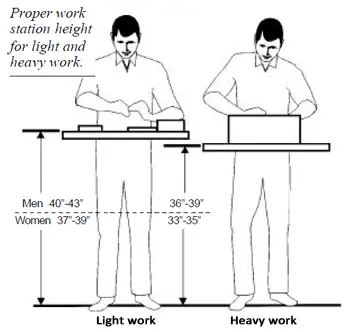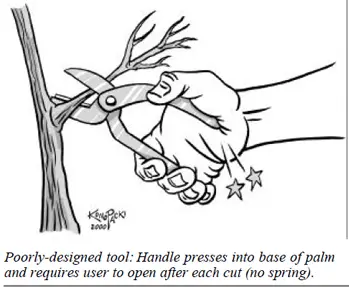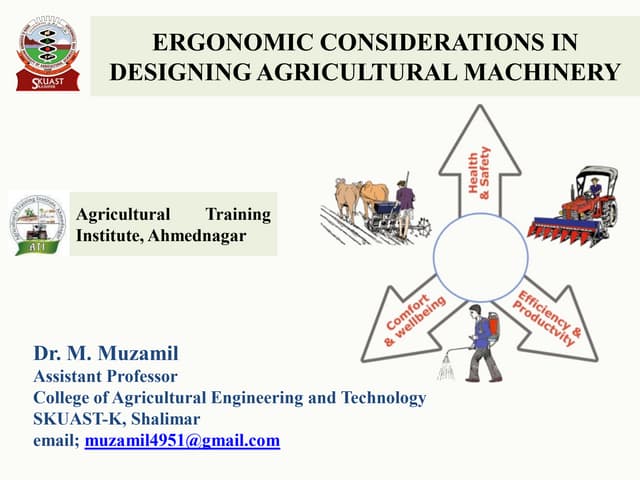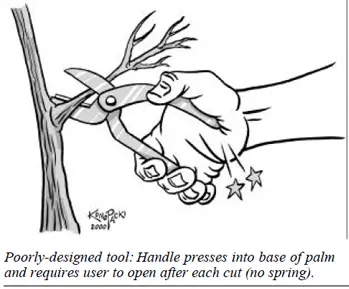This post may contain affiliate links which means I may receive a commission for purchases made through links. Learn more on my Private Policy page.
In this article, you will explore the essential ergonomic considerations for using hand-held farm tools. With a focus on promoting comfort and minimizing physical strain, we will delve into the importance of selecting tools with proper handle design and weight distribution. Furthermore, we will discuss the significance of maintaining good posture and using proper body mechanics while using these tools. By implementing these ergonomic principles, you can enhance your efficiency, reduce the risk of injury, and make your farming tasks more enjoyable and rewarding.

This image is property of nasdonline.org.
Proper Handle Design
Choosing the Right Material
When it comes to choosing the material for the handle of a hand-held farm tool, there are a few factors to consider. First and foremost, durability is key. You want a material that can withstand the rigors of daily use on the farm without wearing down or breaking easily. Many farm tool handles are made from wood, such as hickory or ash, due to their strength and ability to absorb shock. Another option is fiberglass, which is lightweight yet strong. Ultimately, the choice of material will depend on personal preference and the specific needs of the tool.
Ensuring the Right Grip Size
The grip size of a hand-held farm tool is crucial for comfortable and effective use. If the handle is too thick, it can strain your hand and cause fatigue over time. Conversely, if the handle is too thin, you may have difficulty maintaining a firm grip, leading to reduced control and potential accidents. To determine the right grip size, consider the size of your hand and find a handle that allows you to comfortably wrap your fingers around it without straining. Some handles offer adjustable grip sizes, which can be particularly useful if multiple people will be using the tool.
Considering Handle Shape
The shape of the handle plays a significant role in the ergonomics of a hand-held farm tool. A well-designed handle should provide a comfortable grip and minimize stress on your hand, wrist, and arm. Straight handles are commonly found on many tools and can be a good option for tasks that require precise control and accuracy. However, for tools that involve repetitive motions or heavy lifting, handles with an ergonomic curve or contoured shape can help reduce strain and distribute the force more evenly. It’s important to try out different handle shapes to find the one that feels most comfortable for you.
Weight and Balance
Finding the Optimal Weight
The weight of a hand-held farm tool can greatly impact your ability to use it effectively and comfortably. If a tool is too heavy, it can quickly lead to fatigue and muscle strain, making it difficult to work efficiently. On the other hand, a tool that is too light may lack the necessary power or stability for certain tasks. Finding the optimal weight depends on the specific tool and the nature of the work it will be used for. It’s important to consider your own strength and endurance, as well as any physical limitations, when selecting a tool with an appropriate weight.
Achieving Ideal Tool Balance
In addition to weight, the balance of a hand-held farm tool is crucial for ease of use and efficiency. A well-balanced tool will feel comfortable in your hand and require less effort to control. The balance point should be located near the area where you grip the tool, allowing for greater control and reduced strain on your muscles and joints. Tools that are too front-heavy can cause your hand to fatigue quickly, while tools that are too back-heavy can be difficult to control. When choosing a tool, consider the location of the balance point and how it aligns with your natural hand movements.
Tool Length
Determining the Appropriate Length
The length of a hand-held farm tool plays a significant role in its usability and comfort. Tools that are too short may require you to stoop or bend over excessively, putting strain on your back and increasing the risk of injury. On the other hand, tools that are too long can become unwieldy and make it difficult to maneuver in tight spaces. The appropriate length will depend on the specific task and your own height and reach. Generally, longer handles are preferred for tasks that require greater reach or leverage, while shorter handles are suitable for close-range or precision work.
Considering Reach and Leverage
When choosing the length of a hand-held farm tool, it’s important to consider the specific tasks for which it will be used. Some tasks, such as pruning branches or reaching high areas, may require a longer handle to provide the necessary reach. Longer handles can also be beneficial for tasks that involve leveraging, such as digging holes or lifting heavy objects. Conversely, shorter handles are typically more suitable for tasks that require precision and control, such as planting seeds or weeding around delicate plants. Consider the range of motion required for your intended tasks and select a tool with an appropriate length.
Handle Length
Selecting the Suitable Handle Length
The length of the handle on a hand-held farm tool is an important aspect of its ergonomic design. The handle length affects your posture and comfort while using the tool, as well as your ability to effectively apply force and control the tool. A handle that is too long can cause overreaching, putting strain on your muscles and joints, while a handle that is too short can limit your range of motion and make it difficult to generate sufficient power. When selecting a tool, consider your own height and reach, as well as the types of tasks you will be performing, to ensure you choose a handle length that promotes proper posture and ease of use.
Avoiding Overreaching or Bending
One of the key considerations when it comes to handle length is avoiding overreaching or bending while using a hand-held farm tool. Overreaching can strain your muscles and joints, leading to discomfort and potential injury over time. Similarly, excessive bending can put strain on your back and increase the risk of lower back pain. By selecting a handle length that allows you to maintain a comfortable posture and work within your natural range of motion, you can minimize the risk of overreaching or bending. Remember to always use proper lifting techniques and take breaks as needed to avoid excessive strain on your body.

This image is property of nasdonline.org.
Vibration and Shock Absorption
Reducing Vibration Transfer
Vibration is a common issue with hand-held farm tools, and prolonged exposure to vibration can lead to fatigue, numbness, and even long-term health conditions like hand-arm vibration syndrome. To reduce the transfer of vibration from the tool to your hand and arm, it’s important to choose a handle that has good shock-absorbing properties. Handles made from materials like wood or certain types of rubber can help absorb and dampen vibrations, minimizing their impact on your body. Additionally, some tools come with built-in vibration dampening features, such as anti-vibration systems or cushioned grips, which can further reduce the risk of vibration-related injuries.
Implementing Shock Absorbing Features
In addition to choosing the right handle material, there are other features that can help enhance shock absorption and reduce the impact of vibrations on your body. For example, some handles are designed with built-in shock-absorbing mechanisms, such as springs or rubber inserts, which help dissipate and absorb the energy generated by the tool. These features can significantly reduce the impact of vibrations on your hand and arm, allowing you to work for longer periods without experiencing excessive fatigue or discomfort. When selecting a hand-held farm tool, look for these additional shock-absorbing features to prioritize your comfort and well-being.
Safety Features
Implementing Blade Guards
Safety is paramount when working with hand-held farm tools, and one important aspect of safety is the inclusion of blade guards. Blade guards protect the cutting edge of the tool when it is not in use, preventing accidental contact and potential injury. These guards can be a simple sheath or cover that slides over the blade, or they can be integrated into the handle design. Regardless of the type of tool, it’s essential to ensure that it comes with a suitable blade guard to minimize the risk of accidents when the tool is not in use.
Including Safety Locks or Releases
Some hand-held farm tools have moving parts or mechanisms that need to be secured when not in use. Safety locks or releases are designed to keep these parts in place to prevent unintended operation or damage. For example, a tool with a retractable blade should have a safety lock to keep the blade securely retracted when not in use. Similarly, a tool with adjustable settings should have a locking mechanism to prevent unintentional changes. Including these safety features not only helps protect you from accidents but also prolongs the lifespan of the tool by preventing unnecessary wear and tear.
Ensuring Proper Blade Covers
In addition to blade guards, hand-held farm tools with detachable blades should come with proper blade covers. Blade covers serve two important purposes: they protect the blade while the tool is not in use and they protect you from accidental cuts or injuries when handling or transporting the tool. The blade cover should fit snugly over the blade, providing full coverage and securely holding it in place. Before using a tool with a detachable blade, always ensure that the blade cover is intact and correctly positioned to minimize the risk of accidents.

This image is property of nasdonline.org.
Handle Angle and Shape
Evaluating Optimal Handle Angle
The angle at which a handle is positioned can greatly affect your comfort and control while using a hand-held farm tool. Handles that are ergonomically designed to match the natural alignment of your wrist and arm can help reduce fatigue and strain on your joints. The optimal handle angle will vary depending on the tool and the task it is intended for. For example, tools that require a downward cutting motion, such as pruning shears, may benefit from handles that have a slight downward angle. It’s important to try out different handle angles to find the one that feels most comfortable and allows for easy, efficient use of the tool.
Considering the Right Shape for a Comfortable Grip
The shape of the handle can greatly impact your ability to maintain a comfortable and secure grip on a hand-held farm tool. Handles that are contoured or have ergonomic curves can conform to the natural shape of your hand, providing increased comfort and reducing the risk of slipping or losing control of the tool. Additionally, some handles have textured or non-slip surfaces that further enhance grip stability, particularly in challenging or wet conditions. Consider the shape and texture of the handle when selecting a hand-held farm tool to ensure that it provides a comfortable grip and optimal control.
Handle Diameter
Selecting an Appropriate Diameter
The diameter of the handle on a hand-held farm tool affects your grip strength and comfort during use. Handles that are too thick may strain your hand and make it difficult to maintain a secure grip, while handles that are too thin can cause discomfort and reduce control. The appropriate handle diameter will depend on the size of your hand and your personal preference. It’s important to choose a handle with a diameter that allows you to comfortably wrap your fingers around it without excessive strain. Handles with adjustable grip sizes can be particularly useful if multiple people with different hand sizes will be using the tool.
Considering Hand Size and Comfort
When selecting the handle diameter for a hand-held farm tool, it’s essential to consider your hand size and comfort. People with smaller hands may find it more comfortable to use a tool with a slightly smaller handle diameter, as it allows for a firmer grip and better control. Conversely, people with larger hands may prefer a slightly larger handle diameter to provide enough space for their fingers to wrap around comfortably. Remember that a proper grip is crucial for maintaining control and minimizing fatigue, so choose a handle diameter that suits your hand size and promotes optimal comfort.

This image is property of cdn.slidesharecdn.com.
Maintenance and Care
Keeping Tools in Good Condition
Proper maintenance and care are essential for ensuring the longevity and optimal performance of hand-held farm tools. Regularly inspect your tools for any signs of wear or damage, and address them promptly to prevent further deterioration. Clean your tools after each use to remove dirt, debris, and moisture that can cause corrosion or rust. Applying a protective coating or lubricant to metal parts can help prevent rust and maintain smooth operation. Sharpen blades regularly to ensure clean and efficient cuts, and replace any worn or damaged handles or grips. By taking care of your tools, you can extend their lifespan and ensure they are always ready for use.
Addressing Wear and Tear
Over time, hand-held farm tools may experience wear and tear due to regular use and exposure to various conditions. It’s important to address any signs of wear or damage promptly to prevent further deterioration and maintain the tool’s functionality and safety. Inspect the handles for cracks, splinters, or loose parts, and replace them if necessary. Check for any bending or warping in the tool’s structure, as this can affect its performance and safety. Additionally, regularly inspect moving parts or mechanisms for signs of wear or malfunction, and repair or replace them as needed. Proper maintenance and timely repairs will help ensure that your tools remain in good working condition and safe to use.
Task-Specific Considerations
Evaluating Grip Adjustability for Different Tasks
Different farm tasks require different levels of grip adjustability in hand-held tools. Some tasks may require a tight grip for maximum control and power, while others may benefit from a looser, more relaxed grip. When selecting a tool, consider the level of grip adjustability it provides and whether it aligns with the requirements of your intended tasks. Some tools offer adjustable grip mechanisms, such as ratchet handles or adjustable tension settings, that allow you to customize the grip strength to suit your needs. Having the ability to adjust the grip can help reduce fatigue and enhance comfort during prolonged or repetitive tasks.
Considering Weight Distribution for Specific Uses
Weight distribution plays a crucial role in the usability and efficiency of hand-held farm tools for specific tasks. Some tasks require a tool with a balanced weight distribution, evenly distributing the force across the entire tool. This can help reduce fatigue and strain on specific muscle groups, allowing for longer and more comfortable use. However, there may be instances where a tool with a heavier head or blade is more suitable, such as for tasks that require additional power or impact force. Consider the weight distribution of a tool and how it aligns with the requirements of your specific tasks to ensure optimal performance and safety.
In conclusion, proper handle design is essential for ergonomic and efficient use of hand-held farm tools. By considering factors such as the material, grip size, handle shape, weight, balance, length, angle, diameter, vibration absorption, safety features, and task-specific considerations, you can select tools that prioritize your comfort, control, and safety. Additionally, regular maintenance and care will help prolong the lifespan of your tools and ensure they are always in good working condition. By prioritizing proper handle design and ergonomics, you can enhance your productivity and enjoyment while working with hand-held farm tools.

This image is property of image.slidesharecdn.com.
This post may contain affiliate links which means I may receive a commission for purchases made through links. Learn more on my Private Policy page.

